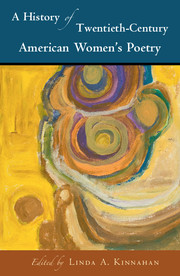Book contents
- Frontmatter
- Contents
- List of figures
- List of contributors
- Preface
- Acknowledgments
- PART I MAPPINGS AND CHRONOLOGIES
- 1 Critical Mapping I: The Category of the “Woman Poet” – An Introduction, by Way of Mapping
- 2 Critical Mapping II: Reading American Poetry by Women
- 3 Chronology I: American Women Poets, 1900–1950
- 4 Chronology II: American Women Poets, 1950–2000
- PART II ETHNICITY, RACE, AND IDENTITY
- PART III MATERIAL FORMATIONS
- PART IV LINEAGES, TIES, AND CONNECTIONS
- PART V FORM, LANGUAGE, AND TEXT
- PART VI CODA
- Bibliography
- Index
1 - Critical Mapping I: The Category of the “Woman Poet” – An Introduction, by Way of Mapping
from PART I - MAPPINGS AND CHRONOLOGIES
Published online by Cambridge University Press: 05 June 2016
- Frontmatter
- Contents
- List of figures
- List of contributors
- Preface
- Acknowledgments
- PART I MAPPINGS AND CHRONOLOGIES
- 1 Critical Mapping I: The Category of the “Woman Poet” – An Introduction, by Way of Mapping
- 2 Critical Mapping II: Reading American Poetry by Women
- 3 Chronology I: American Women Poets, 1900–1950
- 4 Chronology II: American Women Poets, 1950–2000
- PART II ETHNICITY, RACE, AND IDENTITY
- PART III MATERIAL FORMATIONS
- PART IV LINEAGES, TIES, AND CONNECTIONS
- PART V FORM, LANGUAGE, AND TEXT
- PART VI CODA
- Bibliography
- Index
Summary
The twentieth century in America spans a period tumultuous in its changes, multiplicitous in its populations, and effusive in its poetic and critical voices. How women have absorbed, commented upon, engaged with, defied, celebrated, and contributed to the varied cultures of poetry emergent alongside American modernity offers rich material and raises many questions in A History of Twentieth-Century American Poetry by Women. Indeed, questions motivate much of the literary history told here, beginning with fundamental questions of who, when, why, and how – questions of visibility and record are inseparable from questions of analysis and interpretation. Taken together, these chapters map ways of thinking about and through a particular, central set of questions compelled by the project itself and its defining terms: what does the category of “American women poets” mean, and how might it be understood (and justified) through the telling of many necessary, but necessarily incomplete, histories? How is history told, to what purpose, by whom and for whom? How can histories remain open to multiple narratives, voices, or critical engagements? What do we mean by “woman”? What do we mean by “American”? What do we mean by “history”? The chapters that follow address these questions from many directions and through myriad lenses, and uncover a rich panoply of responses.
As a starting point, it is accurate to say that the category of “women poets” has relentlessly coursed through discussions of poetry since well before the twentieth century, often for the purpose or with the effect of defining the woman poet as separate, different, and usually inferior to her male counterparts. Through much of the century and prior, she is most often presumed white and heterosexual. Value-laden language consistently places women poets into a lower sphere, endowed with lower faculties of feeling and fancy, and capable only of a limited scope and craft. Within the cultural binaries that hold through much of the century, women poets are associated with popular mass culture rather than art, with expressions of emotion rather than higher thinking. Historically, women are positioned in poetry as either objects (not makers) of culture or, if the rare maker, far less capable than men, or not really “womanly.” The idea of “woman” and the idea of “poet” have, through much of Western poetry's history, seemed utterly incompatible, even, at times, to women poets themselves.
- Type
- Chapter
- Information
- Publisher: Cambridge University PressPrint publication year: 2016



